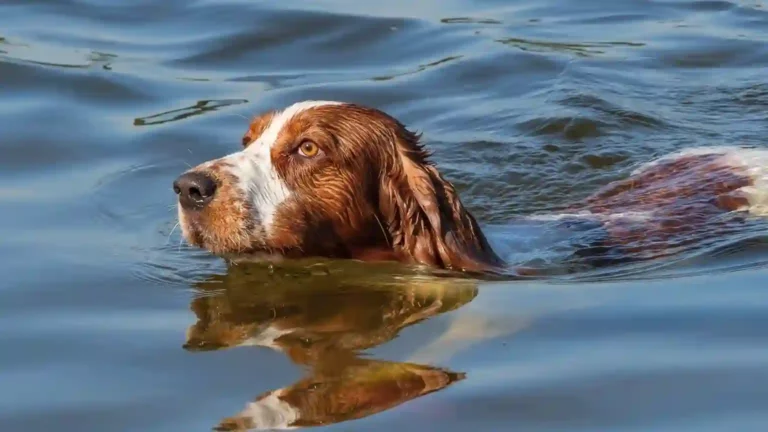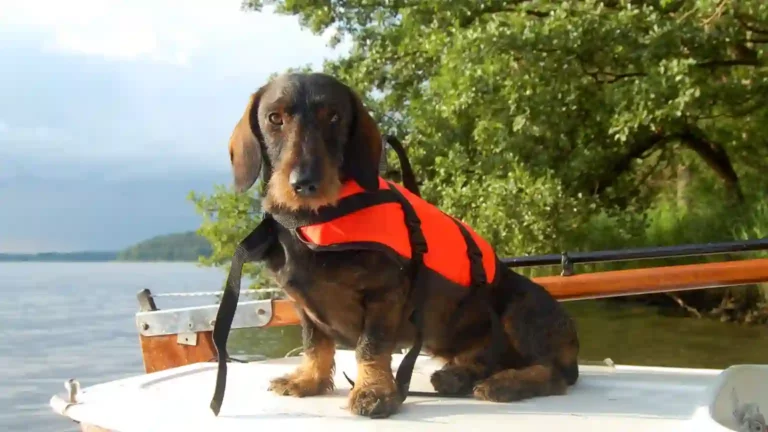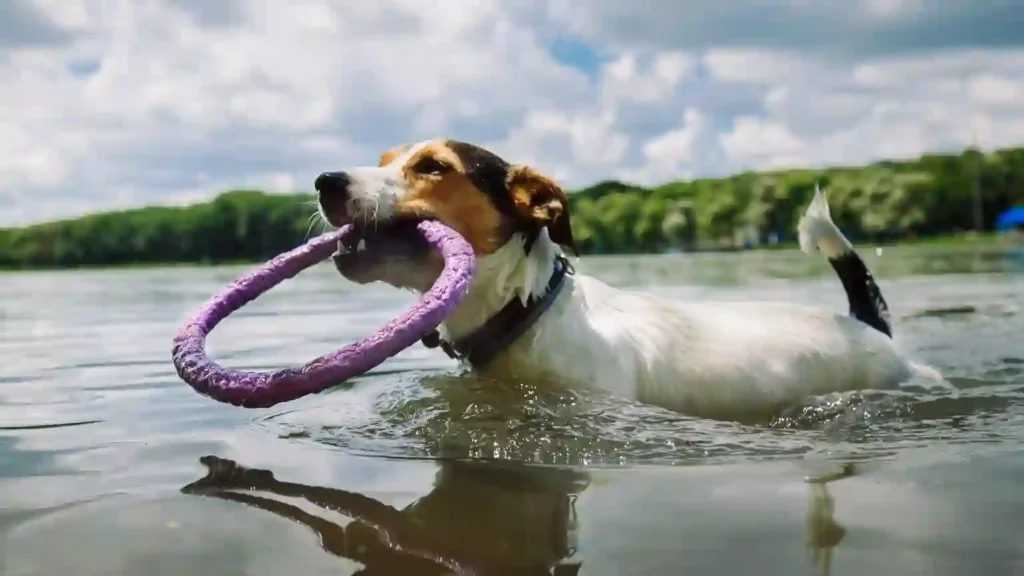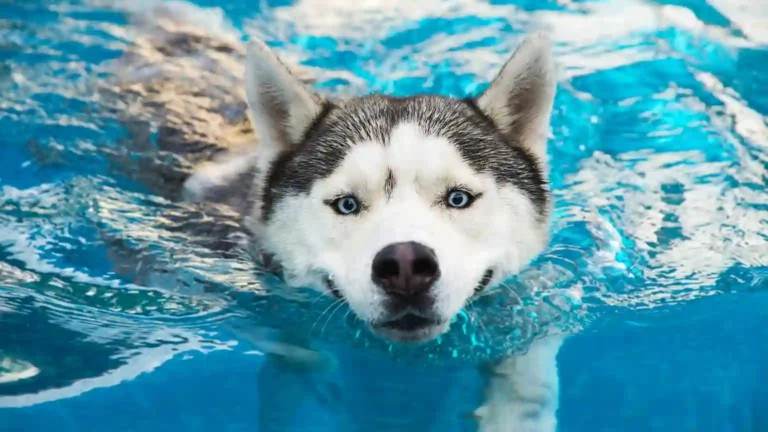How to Teach Your Dog to Swim (6-step guide)
- Claudia Weise
- Updated: 2023-09-06
The image of a swimming dog embodies pure joy of life for many people. Maybe you would like to teach your four-legged friend how to swim. Here you can learn how to do it properly.

A jump into the cool water, splashes of water glistening in the sun, and a four-legged friend happily wagging his tail in the water.
Attention water rats! Who doesn't love jumping into the cool water on hot summer days and cooling off in the water? You can give your four-legged friend the same pleasure.
A dog splashing happily in the water is not only a beautiful sight, but also a sign of a fit and happy four-legged friend. In this article you will learn how to teach your dog to swim.
Why is swimming healthy for your dog?
Swimming is an excellent activity for your dog, both mentally and physically. It trains the muscles in a very special way, because the body moves differently in the water than on land.
This type of training is particularly easy on the joints and therefore ideal for older dogs or dogs with joint problems. The coolness of the water not only provides refreshment on hot days, but also protects against overheating.
The stamina your dog develops while swimming will benefit him in other activities as well. And last but not least: Swimming can strengthen the bond between you and your dog because you are experiencing something new together.
Required accessories:

Before you start, you should get a few things:
- Life jacket for dogs: It gives additional buoyancy and is especially recommended for beginners or unsure swimmers.
- Water toys: Whether it's a ball or a squeaky duck, toys can serve as a motivational tool and show the dog that water is fun.
- Treats: Positive reinforcement is the key to successful learning.
- Towel or dry towel: To dry off after swimming, because no one wants a wet dog in the car.
The ideal age for swimming training
You can begin learning to swim as soon as your puppy is fully vaccinated and the vet has given the green light for him to play with other dogs and explore different environments.
This is usually at 16 weeks of age or more. Here are some things you should keep in mind:
Young puppies are more susceptible to disease. It is important to make sure they have received all necessary vaccinations, especially if you plan to take them to public places such as lakes or beaches where they may come in contact with other dogs.
The window of opportunity for early socialization of puppies closes at about 14 to 16 weeks of age. This is the time when puppies are most receptive to new experiences. Initial positive contact with water during this time can help develop a lifelong love of swimming.
But be careful: Even if you start swimming early, you should always make sure that it remains a positive experience for the puppy. Don't overwhelm him and make sure the water is not too cold. Puppies can get hypothermia more easily than adult dogs.
Some large dog breeds may take longer to develop full coordination. For these breeds, it may be wise to start swim training a little later so that they have enough strength and coordination to be able to swim.
Every puppy is different. Some are crazy about water from the start, while others need more time and encouragement to feel comfortable. Watch your puppy and go at his own pace.
Once your puppy is vaccinated and healthy, you can begin learning to swim. It's always good to start early, but it's also important to be patient, understanding and responsive to your puppy's individual needs.
6-Step Guide:

1) Water habituation
It all starts with small steps. You can start by offering your dog a shallow bowl or wading pool to play and splash in. The sound and feel of water against your paws can help reduce anxiety. Fill it only slightly at first so your dog can jump in without fear. Slowly increase the amount of water to overcome your dog's fear of depth. Let him splash with his paws so he can get used to the water.
2) Confidence building on the large body of water
Find a quiet place by the lake or pond. To make your dog feel safe in the water, you should accompany him. Go with him into the water and encourage him with your presence. Have fun together. Play with him in the shallow water so he has positive experiences.
3) Fun and games
Now the water toy comes into play. Throw it into the water from a short distance and encourage your dog to fetch it. Use water toys like floating balls or squeakers as a motivational tool. Throw them in very shallow areas at first so the dog doesn't have to swim. Gradually increase the distance the toy travels to encourage your dog to venture further into the water.
4) First swimming strokes
When your dog is comfortable in shallow water, slowly lead him into deeper water. As soon as he can no longer stand, he will instinctively start paddling. Support your dog. Give him extra buoyancy by holding his hip while he attempts his first swims.
5) Positive reinforcement
Every time your dog makes progress - whether it's going a little further into the water, getting the toy out of the water for the first time, or doing the first swim - reward him with treats and words of praise. Repeat the exercises regularly, but be careful not to overwhelm your dog.
6) Regular practice
As with any new skill, practice is the key. Care should be taken not to overwork the dog and to give him enough breaks. Short, regular training sessions are more effective and less stressful for your dog than long training sessions. Breaks are important: After swimming, your dog should always have enough time to rest.
The ideal place for swimming training
The environment plays a big role in learning to swim. Quiet lakes or ponds often have shallow banks and are ideal for beginners. Shallow river banks can also be suitable, as long as the current is not too strong.
There are also special dog swimming pools. It is important to avoid crowded or noisy places, as they can easily overwhelm the dog.
What to consider?
Water quality should always be kept in mind. Polluted water can lead to health problems. Safety first, so watch out for hazards like strong currents or sharp objects in the water.
Even if dogs have their own fur, they should be protected from too cold water to avoid hypothermia.
Swimming in different bodies of water presents different challenges and risks. It is important to know the specifics of each body of water to ensure the dog's safety. Here are some examples:
| Waters | What to consider? |
|---|---|
| Bach | Flow: Even in small streams, the current can be strong. Make sure that your dog is not carried away, especially after rainfall. Rocky shores: Streams can have rocky or slippery banks that make it difficult for your dog to get in and out. |
| See | Standing Waters: Algae can form in standing water during the warm months, some of which can be toxic. Find out beforehand if algae blooms are known to occur. Different depths: Some lakes can suddenly become deep. Make sure your dog doesn't jump into deep water right away when you get used to it. |
| Rivers | Flow: Rivers often have strong currents that can easily sweep a dog along. Look for visible signs such as waves or whirlpools. Uncertain depth: As with lakes, the depth of a river can change suddenly. Access to the shore: Access to the river can be difficult or slippery, especially on steep banks. |
| Fishing spots | Hooks and cords: At fishing spots, there is a risk of lost or left hooks and lines being left in the water or on the shore. Consideration for anglers: Dogs can scare fish away. Keep your dog away from anglers and be aware of fishing spots that are closed to dogs. |
| Sea | Salt water: Salt water can dehydrate the dog and is not good for the stomach. Make sure he doesn't swallow too much of it and always give him fresh drinking water. Waves: Waves can be intimidating or dangerous for dogs, especially inexperienced swimmers. Currents: Tides and underwater currents can be very strong. Even experienced swimmers can get into trouble. Marine animals: Watch out for jellyfish or sharp shells on the shore that can hurt your dog. |
General advice for all waters:
- Always keep an eye on your dog while swimming.
- Always enter new waters yourself first to check conditions.
- Keep your dog on a leash until you are sure the area is safe.
- After each swim, regardless of the body of water, the dog should be thoroughly rinsed with clean water to remove pollutants, salt or small organisms.
By learning about the specific conditions of each body of water and always staying on the safe side, you can ensure that swimming remains safe and enjoyable for you and your dog.
After swimming - 8 tips and tricks

When your dog gets out of the water, there are a few things you should do to ensure his health and safety and to provide him with an enjoyable experience:
1. rinse thoroughly
Freshwater: Rinse your dog thoroughly with clean water to remove any impurities, salt, chlorine or algae residue. This is especially important if he has been swimming in the sea or in a chlorinated swimming pool.
Showers: If you're at a beach or lake where there are showers, use them to rinse your dog off.
2. drying
- Towel: Rub your dog well with a towel to remove excess water. This will also help reduce the risk of a cold.
- Ears: Water in the ears can cause infections. Gently dry your dog's ears with a soft cloth or cotton ball. Avoid inserting objects deep into the ear canal.
- Hair dryer: If your dog allows it, you can use a blow dryer on a low setting to dry it faster, especially for dogs with thick coats.
3. control
- Paws: Examine your dog's paws for cuts or foreign objects, especially if he has been walking on rocky or rough surfaces.
- Skin and coat: Examine your dog for ticks, jellyfish remains or other foreign objects.
4. fresh drinking water
Make sure your dog has access to fresh drinking water, especially after swimming in salt water.
5. silence
Let your dog rest and warm up, especially if he has been swimming in colder waters.
6. surveillance
Watch for signs of malaise, vomiting or diarrhea in the first few hours after bathing, especially if your dog has been drinking water from unknown sources.
7. regular maintenance
If your dog swims frequently, his coat may need extra care to stay healthy. Regular bathing with a mild shampoo may be necessary.
8. vet visit
If your dog has ear infections, skin irritation or other health problems after swimming, you should see a veterinarian.
All in all, swimming should be a positive experience for your dog. Careful follow-up will help minimize health risks and keep your dog fit for future swims.
Do's and Don'ts:
Do's:
- Always stay calm and patient. Dogs sense your energy.
- Always keep an eye on your dog.
- A life jacket is essential for unsafe swimmers.
Don'ts:
- Throwing your dog in the water is an absolute no-go.
- Coercion has no place in learning to swim.
- Don't overdo it and give your dog enough breaks.
Frequently Asked Questions
Although many believe that all dogs can swim instinctively, some breeds have difficulty. Bulldogs, for example, often have difficulty in the water because of their body shape.
Quality goes before quantity. Short but regular sessions are better than long, strenuous sessions.
Patience is the key. Make water a positive experience, whether through toys, treats, or simply your presence and encouragement.
Conclusion
Swimming is not only fun and cooling for dogs, but also a great way to get exercise. With the right technique, patience and understanding, almost any dog can discover the joy of swimming.
With patience, empathy and positive reinforcement, your dog will feel more and more confident in the water over time. And who knows, maybe he will soon become a real water pro!
Remember that it is important to make the process without pressure and with a lot of love. Have fun in the water!

I'm editor-in-chief at Hundeo and when it comes to dogs, my heart beats faster. My goal is to publish the best dog guides on the web. There is a lot of passion in every article and I welcome any feedback to constantly improve our content.
Share Now:

